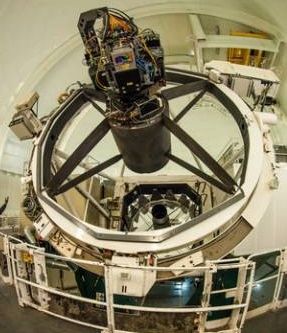
17/06/2015
First light for PAU camera, designed to study dark energy
First light for PAU camera, designed to study dark energy
About the composition of the universe, physicists are sure of one thing: their ignorance. Indeed, if 5% of the universe is made of well known atoms, the remaining 95% are made of both unknown matter (the so-called dark matter, 25%) and unknown energy (the so-called dark energy, 70%) that explains why the expansion of the universe is accelerated.
To know more about this energy, the Physics of the Accelerating Universe (PAU) Spanish project is based on the development of a special camera built with the participation of IFAE (project leader), IEEC and PIC, all three on the Universidad Autónoma de Barcelona (UAB) campus, the key Barcelona Synchrotron Park partner.
The camera was successfully installed on the William Herschel telescope at the Observatorio del Roque de los Muchachos (ORM) on La Palma-Canary Island on June 3. The tool is especially designed to precisely measure the distance between galaxies and thus study how universe expands at an ever faster pace.
The PAUcam was designed and built in six years by a consortium of institutions that includes the Institute for High Energy Physics (IFAE), the Institute for Space Sciences (ICE-CSIC/IEEC), the Scientific Information Centre (PIC), all three on the UAB campus, and the Centre for Research in Energy, Environment and Technology (CIEMAT) and the Institute of Theoretical Physics (IFT-UAM/CSIC).
To know more about this energy, the Physics of the Accelerating Universe (PAU) Spanish project is based on the development of a special camera built with the participation of IFAE (project leader), IEEC and PIC, all three on the Universidad Autónoma de Barcelona (UAB) campus, the key Barcelona Synchrotron Park partner.
The camera was successfully installed on the William Herschel telescope at the Observatorio del Roque de los Muchachos (ORM) on La Palma-Canary Island on June 3. The tool is especially designed to precisely measure the distance between galaxies and thus study how universe expands at an ever faster pace.
The PAUcam was designed and built in six years by a consortium of institutions that includes the Institute for High Energy Physics (IFAE), the Institute for Space Sciences (ICE-CSIC/IEEC), the Scientific Information Centre (PIC), all three on the UAB campus, and the Centre for Research in Energy, Environment and Technology (CIEMAT) and the Institute of Theoretical Physics (IFT-UAM/CSIC).
More news
24/09/2015
Rankings: UAB, UB and UPF Confirm the Quality of the Universities of Barcelona
18/09/2015
With Stradivarius, Design and Fashion Arrive in the Barcelona Synchrotron Park
09/09/2015
The ALBA Synchrotron in the Development of Future Computers
03/09/2015
Travelling to Mars Is In Progress Near the Barcelona Synchrotron Park
09/08/2015
A Synchrotron Is Also Good at Paleontology, Art or History
29/07/2015
Barcelona, an Attractive City for Foreign Direct Investments









